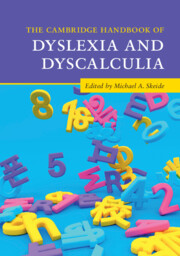Book contents
- The Cambridge Handbook of Dyslexia and Dyscalculia
- The Cambridge Handbook of Dyslexia and Dyscalculia
- Copyright page
- Contents
- Figures and Tables
- Contributors
- Acknowledgements
- General Introduction
- Part I Theoretical Frameworks and Computational Models
- Part II Cognitive Profiles and Behavioural Manifestations
- Part III Genetic and Environmental Influences
- Part IV Neurodevelopmental Foundations
- Part V Gender, Ethnicity, and Socioeconomic Background
- Part VI Cultural Unity and Diversity
- Part VII Early Prediction
- Part VIII Intervention and Compensation
- 19 Randomized Controlled Trials in Dyslexia and Dyscalculia
- 20 Cognitive Enhancement and Brain Stimulation in Dyslexia and Dyscalculia
- 21 Persistence and Fade-Out of Responses to Reading and Mathematical Interventions
- Summary: Intervention and Compensation
- Part IX Best Practice – Diagnostics and Prevention
- Part X Best Practice – Schooling and Educational Policy
- General Summary
- References
- Index
- References
20 - Cognitive Enhancement and Brain Stimulation in Dyslexia and Dyscalculia
from Part VIII - Intervention and Compensation
Published online by Cambridge University Press: 28 July 2022
- The Cambridge Handbook of Dyslexia and Dyscalculia
- The Cambridge Handbook of Dyslexia and Dyscalculia
- Copyright page
- Contents
- Figures and Tables
- Contributors
- Acknowledgements
- General Introduction
- Part I Theoretical Frameworks and Computational Models
- Part II Cognitive Profiles and Behavioural Manifestations
- Part III Genetic and Environmental Influences
- Part IV Neurodevelopmental Foundations
- Part V Gender, Ethnicity, and Socioeconomic Background
- Part VI Cultural Unity and Diversity
- Part VII Early Prediction
- Part VIII Intervention and Compensation
- 19 Randomized Controlled Trials in Dyslexia and Dyscalculia
- 20 Cognitive Enhancement and Brain Stimulation in Dyslexia and Dyscalculia
- 21 Persistence and Fade-Out of Responses to Reading and Mathematical Interventions
- Summary: Intervention and Compensation
- Part IX Best Practice – Diagnostics and Prevention
- Part X Best Practice – Schooling and Educational Policy
- General Summary
- References
- Index
- References
Summary
In this chapter, we provide an overview of different types of cognitive enhancement techniques that target key neural regions related to dyslexia and dyscalculia. The main emphasis is on non-invasive brain stimulation (NIBS), such as transcranial magnetic stimulation (TMS) and transcranial electrical stimulation (tES). The former sends a pulse of current through a coil to evoke a magnetic field that penetrates the skull and enters the brain. The direction of neuromodulation by TMS is controlled by the stimulation frequency.
- Type
- Chapter
- Information
- The Cambridge Handbook of Dyslexia and Dyscalculia , pp. 350 - 361Publisher: Cambridge University PressPrint publication year: 2022

